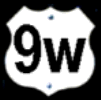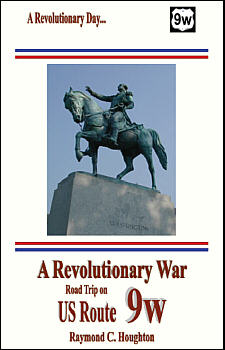A REVOLUTIONARY DAY
|
 |
A REVOLUTIONARY DAY
|
 |
 US
Route 9W goes from New Jersey to Upstate New York paralleling the Hudson River
along its west bank, passing through the Highlands of New York and skirting the
east side of the Catskill Mountains. There are many historic areas to discover
and explore along this route — history that covers the entire American
Revolution from 1775 to 1783. This book presents a one-day, road trip through
these areas, but be warned — with so much to see, it could easily take a
week.
US
Route 9W goes from New Jersey to Upstate New York paralleling the Hudson River
along its west bank, passing through the Highlands of New York and skirting the
east side of the Catskill Mountains. There are many historic areas to discover
and explore along this route — history that covers the entire American
Revolution from 1775 to 1783. This book presents a one-day, road trip through
these areas, but be warned — with so much to see, it could easily take a
week.
There were many heated exchanges along the Hudson River
between American forces and British forces. In 1777, George Washington worried
that "the loss of the Highland passes would open the navigation of the
river, and enable the enemy, with facility, to throw their force into Albany,
get into the rear of General Gates, and either oblige him to retreat, or put him
between two fires." Fortunately for General Gates, the “fire” to his
north was put out with a victory at Saratoga and the “fire” to his south was
halted near Kingston. In 1778, Washington fortified the Highlands at West Point
and, for the most part, kept the British bottled-up in New York City for the
remainder of the war.
 A Revolutionary Day along historic US Route 9W begins
early in the morning in New York City about thirteen miles south of the start of
US Route 9W. New York City is where the battle for control of the Hudson began
in 1775 and sets the stage for the sites that will be visited during the rest of
the day.
A Revolutionary Day along historic US Route 9W begins
early in the morning in New York City about thirteen miles south of the start of
US Route 9W. New York City is where the battle for control of the Hudson began
in 1775 and sets the stage for the sites that will be visited during the rest of
the day.
From New York City, the road trip goes north along Route 9A to the George Washington Bridge and crosses the Hudson to Fort Lee, New Jersey. In November 1776, Washington was forced to watch from Fort Lee as about 3,000 of his men on the opposite side of the Hudson succumb to heavy fire from about 15,000 British troops.
From Fort Lee, the road trip continues north to Alpine Landing then to Tappan, George Washington’s Headquarters on four separate occasions. From Tappan, the road trip continues north to Stony Point, the site of a daring midnight assault by Americans in 1779. After Stony Point, the road trip follows Route 9W to Fort Montgomery and then to West Point, home of the United States Military Academy. Many of the fortifications and weapons used by the American forces to protect the Hudson River still remain today at West Point.
From West Point, the road trip continues north to New Windsor, the final encampment for the American forces, and then to Washington’s final headquarters at Newburgh. He would spend almost 18 months at this headquarters — more time than he would spend at any other headquarters throughout the war.
From Newburgh, the road trip continues north on Route 9W and concludes in Kingston. In 1777, the British would torch the city, but many Revolutionary War era, stone homes still stand today in the Kingston Stockade.
So, if you're ready
